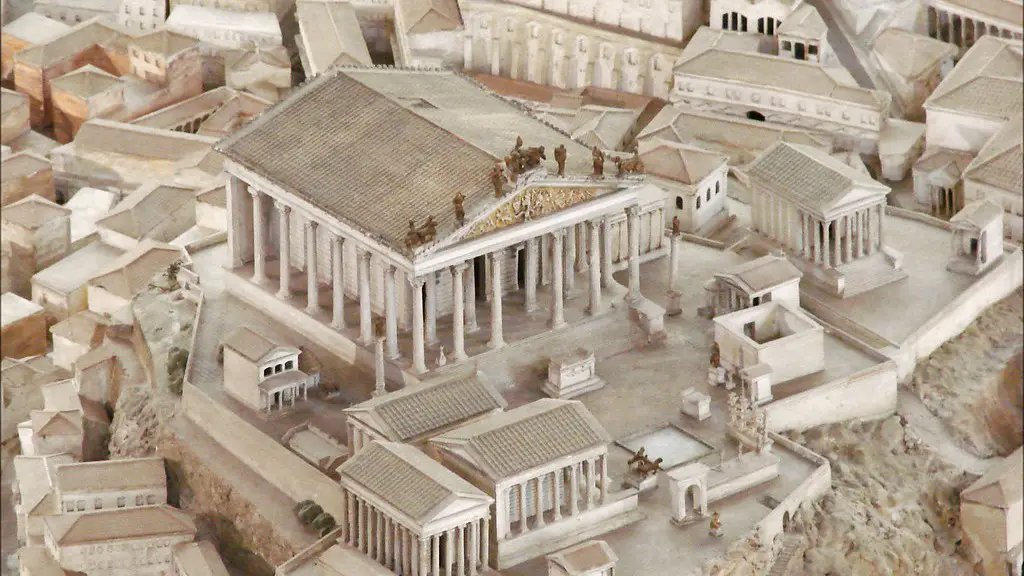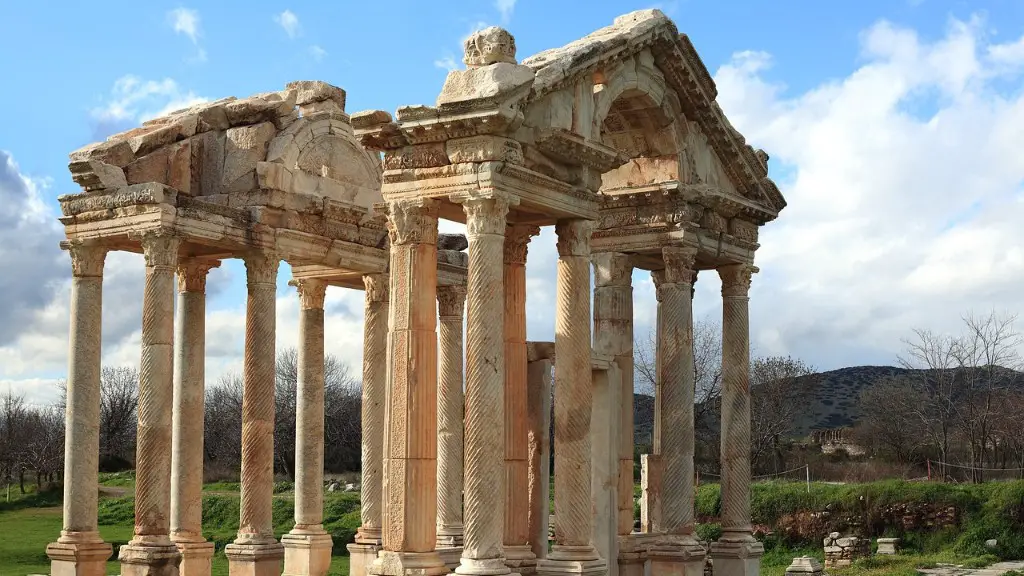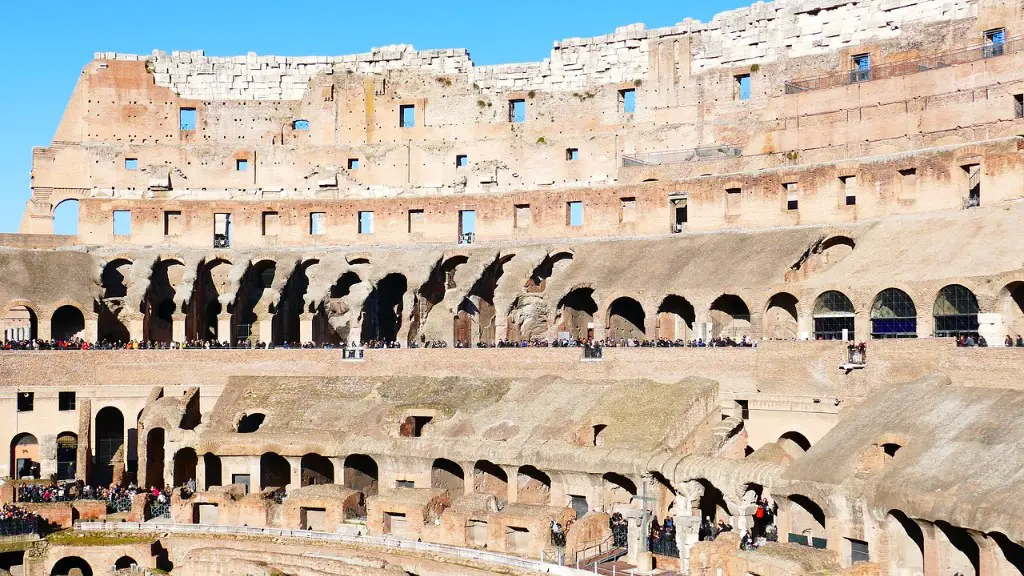Geography of the Mediterranean Basin
Ancient Rome was located in the central region of the Italian Peninsula on the Tiber River. It was part of the Italian peninsula which consists of the Italian sovereign states and the islands of Sicily and Sardinia. In the northwest, it was bounded by the Latin speaking territories of the Roma of Etruria. The surrounding areas included Cisalpine Gaul, Liguria, Umbria, and Campania.
The Mediterranean Sea is the main body of water that surrounds the Italian Peninsula. This played a strategic role in the development of Ancient Rome due to the importance of maritime trade. Italy was in the center of the Mediterranean Sea, surrounded by the regions of Asia Minor, North Africa, and the Balkans. The geography of the Mediterranean Basin allowed for the development of commerce with these regions which contributed to the success of Ancient Rome.
Rise of the Kingdom of Rome
In the 8th century B.C., Rome began as a small city-state. It was ruled by a monarchy and the head of state was known as the King of Rome. This monarchy expanded by conquering the surrounding territories to establish the Kingdom of Rome in 625 B.C. The first two Kings of Rome, Romulus and Remus, were said to have founded the city.
The rule of the Kingdom of Rome was based on a complex set of laws known as the Twelve Tables. These laws created a strong foundation for Roman society and a system that made decisions fairly and objectively. Much of these legal principles are still relevant today and have shaped many modern societies.
The Founding of the Roman Republic
In 509 BC, the monarchy was overthrown by Lucius Junius Brutus and the Roman Republic was established. This marked the beginning of a Republican form of government that was based on the form of law known as the “mos maiorum”, or “stories of the ancestors”. This system entailed a new form of citizens’ rights and responsibilities, which were advocated for by politicians across the Roman Empire. The Senate was the legislative body of the Roman Republic and it included Roman aristocrats with great influence over political decisions. This allowed Rome to begin its rise to an empire.
The Roman army was the foundation for this success. The army was professional and well disciplined with victories in battles that secured the territory held by Rome and extended the power of the Republic and eventual Empire with larger territory.
Rome Becomes An Empire
In 27 BC, Octavian was crowned Augustus and the Roman Republic became the Roman Empire. Immediately, Octavian set out to reform the military, administrative, and social structures of Rome. He divided the empire into provinces based on geography and appointed governors to rule them.
Augustus also developed a civic division to the Roman Empire, creating a sense of pride and loyalty among its citizens. He initiated public works such as the construction of temples and monuments, as well as roads and aqueducts which increased the access to drinking water and building supplies. These public works played a major role in the prosperity of Rome and served as marks of the success of the Empire.
Roman Language and Culture
One of the most significant accomplishments of the Roman Empire was the spread of the Latin language. Latin served as the language of trade and commerce, politics, literature, and the educated classes. It became the common language throughout the Mediterranean region and its use still survives in many areas of the world.
Roman culture was characterized by a strong sense of patriotism and loyalty to Rome. The widespread acceptance of Roman customs and traditions across the Mediterranean basin played an important role in the success of the Empire. Roman architecture, literature, and philosophy laid the foundation for modern European culture.
The Decline of the Roman Empire
Despite its success, the Roman Empire eventually declined due to a combination of factors such as military and economic challenges, political instability and internal conflicts. In 476, the Germanic King Odoacer overthrew the last Roman Emperor, Romulus Augustus, and the Roman Empire came to an end.
The decline of the Roman Empire left behind a legacy of power, influence and a strong belief in the importance of law and justice. The city of Rome remained important in the centuries after the fall of the Empire and it still stands today as a reminder of the greatness of the Roman people.
Legacy of Ancient Rome
The legacy of Ancient Rome can still be felt today in many aspects of civilization. Much of the world’s legal systems, government organization, engineering and architecture have been influenced by Ancient Rome. The Roman language and culture has been a major influence in the Western world since its foundation and even today, Latin is still studied by many as an example of a great language and culture.
Today, Rome is a major tourist destination, popular for its historical sites, monuments, and art. Its lasting legacy which still survives today is a source of pride and admiration for many around the world.
Roman Religion and Philosophy
Religion in Ancient Rome was based on the worship of gods and goddesses. Temples and shrines were built to honor them and sometimes large ceremonies were held to celebrate festivals. Religious beliefs and practices impacted the daily lives of the people and sometimes even major political decisions were based on religious beliefs.
The writings of prominent philosophical thinkers such as Cicero, Seneca, and Marcus Aurelius played a major role in the development of Roman intellectual thought. These philosophers examined life, ethics and morality and some of their ideas influenced major religious movements such as Christianity and Islam.
Roman Economic System
The Roman economy was based on a mix of commerce, agriculture, and trade. Roman trade was extensively connected throughout the Mediterranean region and goods such as wine, olive oil, grain, and slaves were shipped around the Empire. The citizens of Rome were highly dependent on the state for their income and food, as they paid taxes, received subsidies and participated in public works such as the construction of roads and buildings.
The Roman currency, the denarius, was used to pay for goods and services. Taxation on imports and exports, as well as a series of other fiscal measures, were implemented to finance the growth of Rome. The economic system of Ancient Rome, in combination with its efficient military, allowed for the expansion of the Roman Empire.
Roman Technology and Science
The Romans made advances in technology and science that would shape the future of Europe. In engineering, the Romans were responsible for the first use of concrete, the development of efficient siege weapons and the construction of aqueducts and roads.
In terms of science, the Romans improved upon the Greek traditions of mathematics and geometry. They made significant developments in astronomy and the measurement of time. Additionally, the Romans were the first to create medical codices, medical instruments and medicines.
The legacy of Roman science and technology is still evident today in many aspects of modern society. Their innovations have allowed us to continue to push the boundaries of exploration and discovery.


